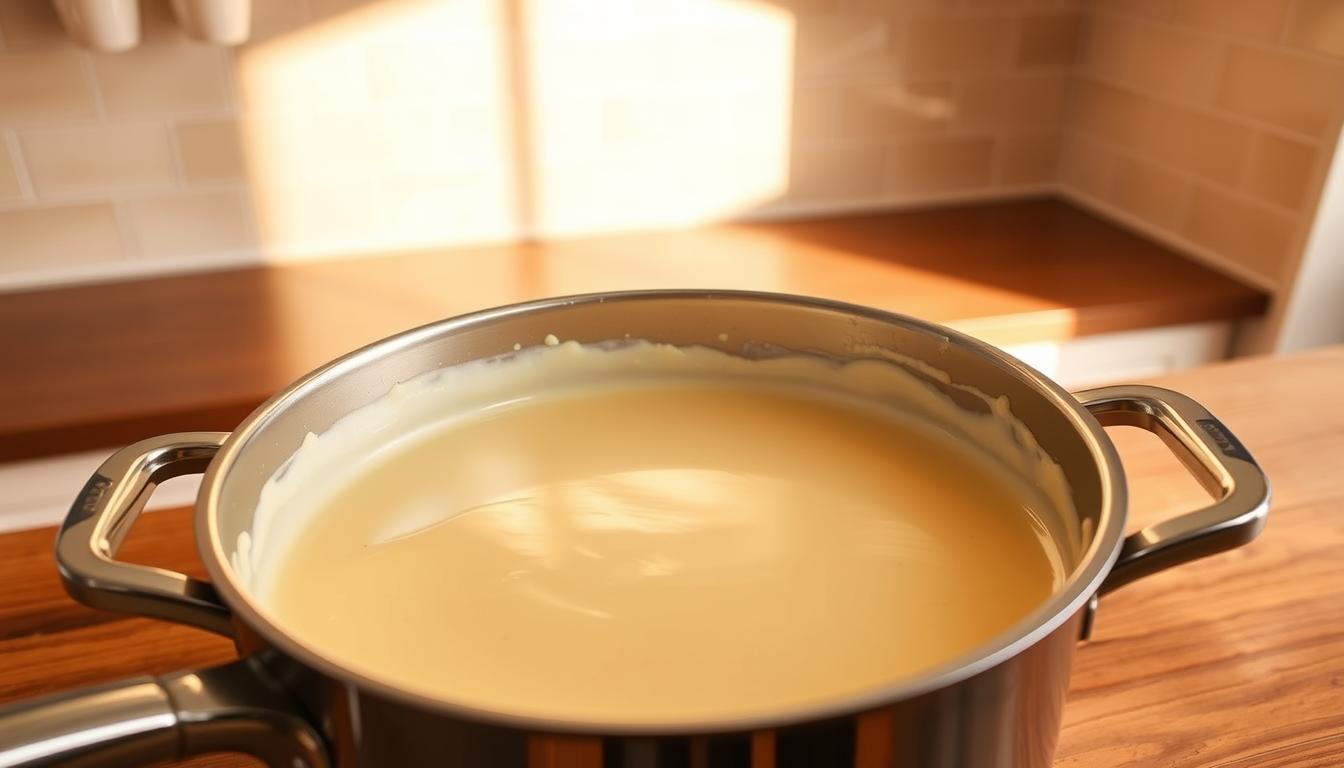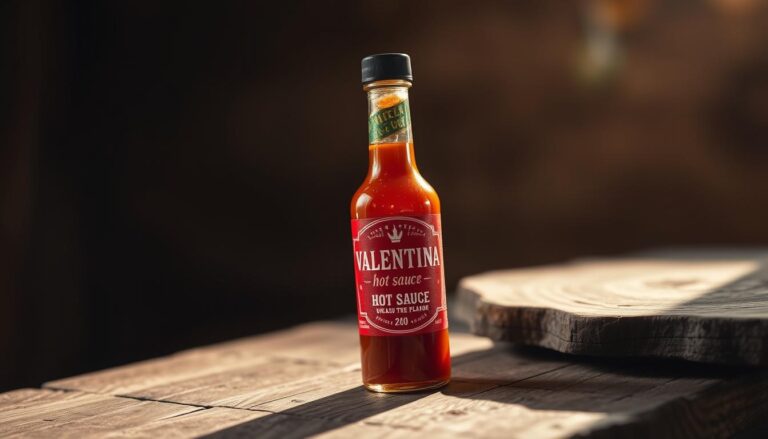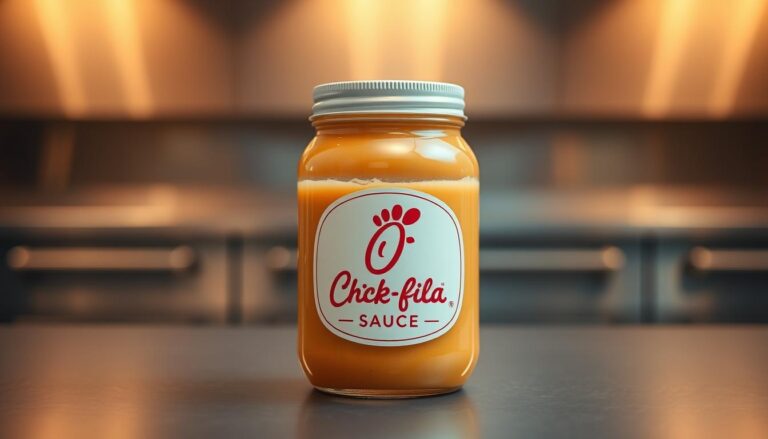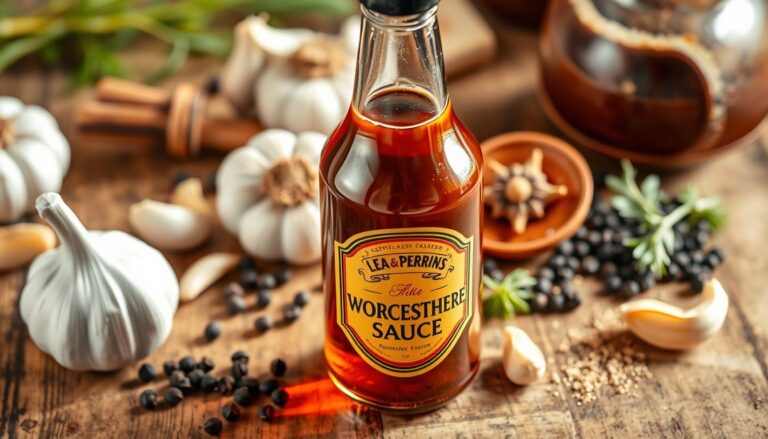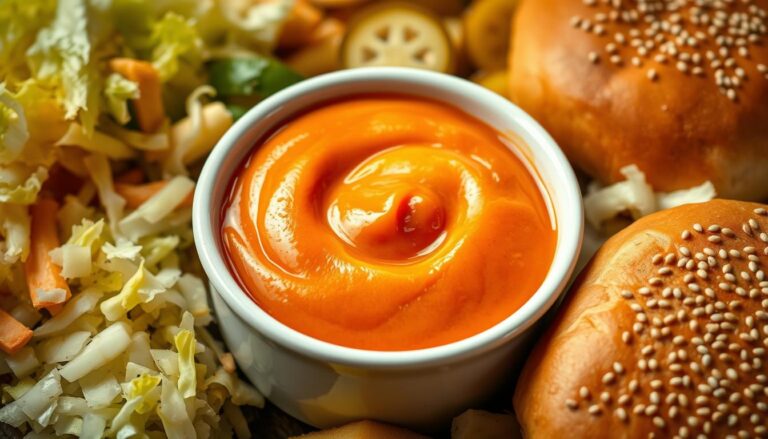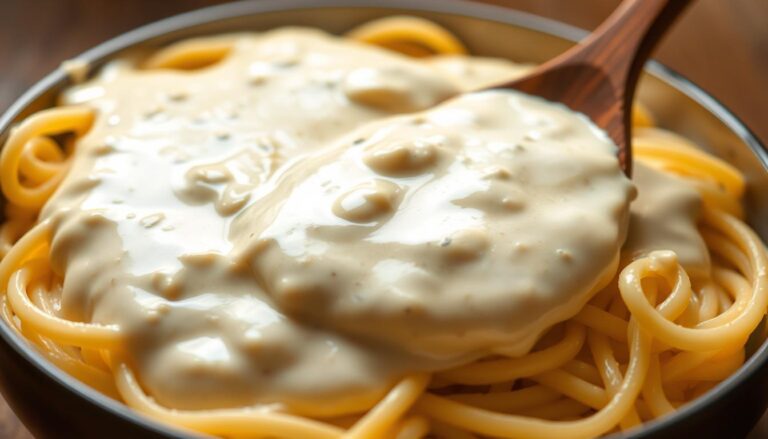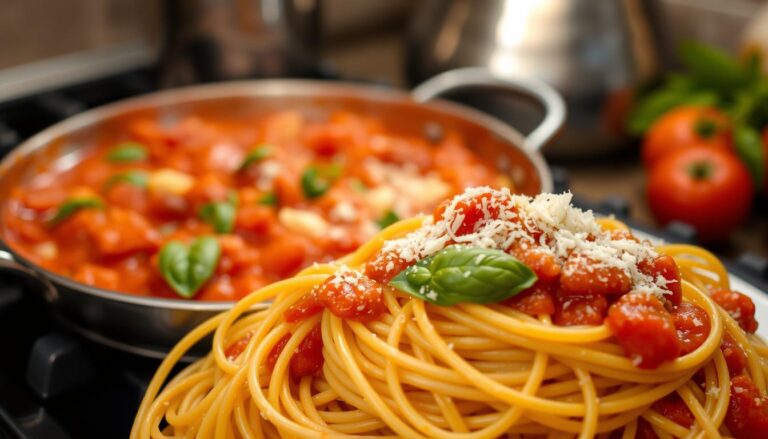Béchamel Sauce: The Versatile Creamy Delight
Béchamel sauce, a cornerstone of French cuisine, has been a staple in many kitchens for centuries. This rich and creamy white sauce is a versatile ingredient that can elevate a variety of dishes, from classic lasagna to steamed vegetables.
Its simplicity and adaptability have made it a favorite among chefs and home cooks alike. Whether you’re looking to add a touch of elegance to your meals or simply seeking to explore the world of French cooking, understanding Béchamel sauce is a great place to start.
Key Takeaways
- A fundamental component of French cuisine
- Versatile ingredient for various dishes
- Simple to prepare and customize
- Adds elegance and flavor to meals
- A great starting point for exploring French cooking
The Rich History of Béchamel Sauce
The origins of Béchamel sauce are deeply rooted in French culinary traditions. This beloved sauce has been a cornerstone of French cuisine for centuries, gracing tables with its rich, creamy texture.
Origins in French Cuisine
Béchamel sauce was named after Louis de Béchamel, a French financier who served as the steward to King Louis XIV. Although it’s often attributed to him, the sauce itself has a history that predates his involvement. The original recipe was developed by François Pierre La Varenne, a renowned French chef, in the 17th century. La Varenne’s work, “Le Cuisinier François,” introduced the sauce to the culinary world, and it quickly became a staple in French cooking.
The sauce’s early adoption was largely due to its simplicity and versatility. It was used in various dishes, from simple vegetable gratins to more elaborate culinary creations. The key to its success lay in its basic ingredients: butter, flour, milk, and seasonings.
Evolution Through Culinary History
As French cuisine evolved, so did Béchamel sauce. It became one of the “mother sauces” classified by Auguste Escoffier in the late 19th century. This classification underscored its importance in French culinary practices. Over time, Béchamel has been adapted and modified, leading to various regional and international variations.
- It has been used in traditional dishes like lasagna and croque monsieur.
- Variations such as Mornay sauce (with cheese) and Soubise sauce (with onions) have expanded its culinary applications.
- Béchamel’s adaptability has ensured its continued relevance in modern cuisine.
The evolution of Béchamel sauce reflects broader trends in culinary history, from the Renaissance through the modern era. Its enduring popularity is a testament to its fundamental role in French cuisine and beyond.
What Makes Béchamel Sauce a Culinary Staple
As one of the five mother sauces, béchamel sauce holds a revered position in the culinary world, offering a rich and creamy base for numerous dishes. Its classification as a mother sauce is attributed to Auguste Escoffier, a renowned French chef who codified these fundamental sauces in the late 19th century.
The Mother Sauce Classification
Béchamel sauce is categorized alongside four other mother sauces: velouté, espagnole, hollandaise, and tomate. This classification signifies its importance as a foundational element in French cuisine. The ability to create a variety of secondary sauces from béchamel makes it an indispensable tool for chefs. For instance, adding cheese transforms béchamel into Mornay sauce, a popular choice for dishes like croque monsieur.
Key Characteristics and Properties
The characteristics of béchamel sauce that make it a culinary staple include its smooth texture and neutral flavor profile. The sauce’s versatility is a significant advantage, as it can be used in a wide range of dishes, from pasta bakes to soufflés. Key properties include:
- A rich, creamy texture achieved by combining a roux with milk.
- A neutral flavor that can be enhanced with various seasonings and aromatics.
- The ability to be adapted into numerous variations by adding different ingredients.
The combination of these characteristics and properties makes béchamel sauce a fundamental component in many cuisines, not just French cuisine. Its adaptability and the ease with which it can be modified make it a favorite among chefs and home cooks alike.
Essential Ingredients for the Perfect Béchamel
Crafting the perfect Béchamel sauce begins with understanding its core ingredients. The quality and proportion of these components directly influence the sauce’s texture, flavor, and overall performance in various dishes.
Butter and Flour: The Roux Base
The foundation of Béchamel sauce is a roux made from butter and flour. The butter adds richness and helps to create a smooth, velvety texture, while the flour serves as a thickening agent. “A good roux is the backbone of many sauces,” as culinary experts often say. To make an effective roux, it’s crucial to cook the butter and flour mixture to the right consistency, typically a pale blonde color, without burning it.
Milk Selection and Quality
The choice of milk significantly impacts the flavor and quality of the Béchamel sauce. Whole milk is traditionally used for its rich, creamy texture. The quality of the milk, in terms of freshness and fat content, directly affects the sauce’s taste and consistency. For a lighter version, one can use low-fat milk, though this may slightly alter the sauce’s richness.
Seasonings and Aromatics
Seasonings and aromatics play a vital role in enhancing the flavor of Béchamel sauce. Common additions include salt, pepper, and a pinch of nutmeg. Some recipes also incorporate aromatics like onion, bay leaf, or cloves, which are typically simmered in the milk before it’s added to the roux. As Auguste Escoffier once noted, “The art of cooking lies in the ability to balance flavors.” Balancing these elements is key to a refined Béchamel sauce.
By focusing on these essential ingredients and their preparation, one can achieve a Béchamel sauce that is both versatile and delicious, suitable for a wide range of culinary applications.
Mastering the Classic Béchamel Sauce Recipe
The simplicity of béchamel sauce belies the nuance and technique required to prepare it perfectly. This mother sauce is a cornerstone of French cuisine, and its preparation is an essential skill for any chef. To master béchamel, one must understand the intricacies of its preparation, from the initial roux to the final consistency.
Preparing the Roux
The foundation of a great béchamel sauce is its roux. To prepare the roux, start by melting 2 tablespoons of butter in a saucepan over medium heat. Once melted, add 2 tablespoons of all-purpose flour, whisking continuously to avoid lumps. Cook the roux for about 2 minutes, until it reaches a pale golden color and has a nutty aroma. This step is crucial as it removes the raw flour taste and adds depth to the sauce.
- Use a medium saucepan to allow for even heating.
- Whisk constantly to prevent the formation of lumps.
- Cook the roux until it is lightly colored to enhance the flavor.
Adding and Cooking the Milk
With the roux prepared, it’s time to add the milk. Gradually pour in 1 cup of warm milk, whisking vigorously to ensure a smooth incorporation. Continue cooking the mixture over medium heat, stirring constantly, until it thickens and coats the back of a spoon. This should take about 5-7 minutes. The key is to cook the sauce slowly and patiently to avoid lumps and achieve a silky texture.
- Warm the milk before adding it to the roux to prevent sudden temperature changes.
- Stir constantly to prevent the sauce from sticking to the bottom of the pan.
- Reduce heat if the sauce starts to boil too vigorously.

Achieving the Perfect Consistency
The final step in making béchamel sauce is achieving the perfect consistency. The sauce should be thick enough to coat the back of a spoon but still pourable. If the sauce is too thick, a small amount of warm milk can be added. Conversely, if it’s too thin, continue cooking it for a few more minutes until it reaches the desired thickness. Season the sauce with salt, nutmeg, and a pinch of white pepper to enhance its flavor.
- Test the consistency by coating the back of a spoon.
- Adjust the seasoning according to the intended use of the sauce.
- For a richer flavor, consider adding a bay leaf or onion clove during cooking and removing it before serving.
By following these steps and tips, you can master the classic béchamel sauce recipe and elevate your culinary creations. Whether used in lasagna, mac and cheese, or as a topping for vegetables, a well-made béchamel sauce adds a richness and depth that is hard to match.
Common Variations of Traditional Béchamel Sauce
The versatility of béchamel sauce is showcased through its various adaptations in different culinary traditions. This classic white sauce has been modified and enhanced to suit a wide range of dishes, from comforting casseroles to sophisticated gourmet recipes.
Mornay Sauce: Adding Cheese
Mornay sauce is a rich variation of béchamel that incorporates grated cheese, typically Gruyère, Cheddar, or a combination of both. This cheesy sauce is perfect for dishes like macaroni and cheese or as a topping for vegetables. To make Mornay sauce, simply stir in the grated cheese into the béchamel until it’s fully melted and smooth. The result is a creamy, cheesy sauce that’s sure to please.
Soubise Sauce: The Onion Variation
Soubise sauce is another delightful variation that adds a sweet and savory flavor to the traditional béchamel. This sauce is made by puréeing cooked onions into the béchamel, creating a smooth and flavorful condiment. Soubise sauce is often served with grilled meats or used as a base for other sauces. The onions add a depth of flavor that complements a variety of dishes.
Nantua Sauce: The Seafood Version
Nantua sauce is a seafood-inspired variation that incorporates crayfish or prawns into the béchamel. This luxurious sauce is typically served with fish or seafood dishes, adding a rich and indulgent flavor. To make Nantua sauce, crayfish or prawns are cooked in the béchamel, and then the sauce is strained to remove the solids, leaving a smooth and creamy sauce.
Other Regional Adaptations
Beyond these well-known variations, béchamel sauce has been adapted in numerous ways across different regions. For example, some recipes may add a sprinkle of paprika or a dash of cayenne pepper to give the sauce a smoky or spicy kick. Others might incorporate different herbs or spices to create unique flavor profiles. The possibilities are endless, making béchamel sauce a versatile foundation for a wide range of culinary creations.
Classic Dishes Featuring Béchamel Sauce
The versatility of béchamel sauce is showcased in various iconic culinary creations that have stood the test of time. This sauce is not just a component; it’s often the foundation that elevates dishes to new heights.
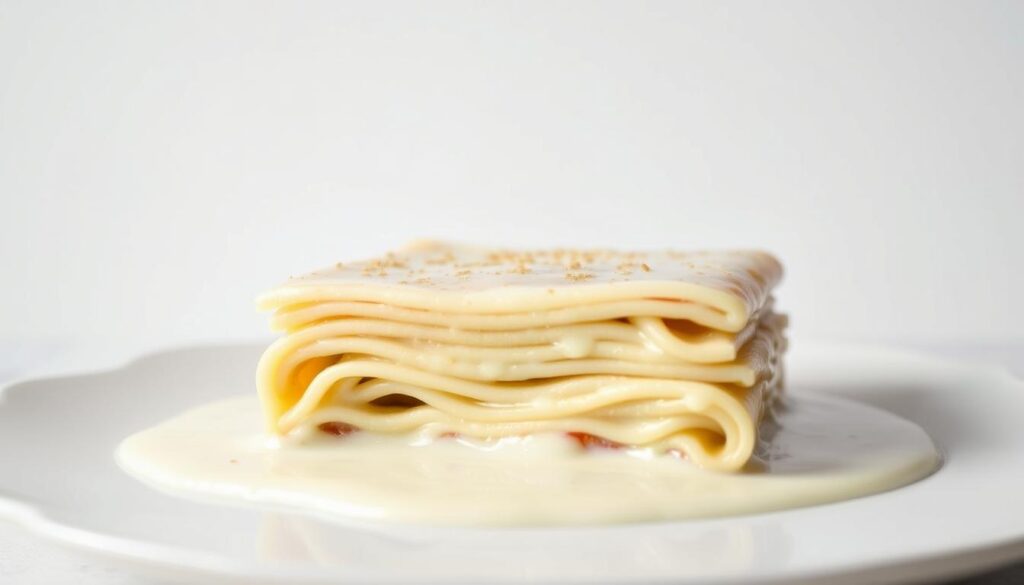
Lasagna and Pasta Applications
Lasagna, a quintessential Italian dish, relies heavily on béchamel sauce for its rich, layered flavor. The sauce is typically combined with layers of pasta, meat ragù, and cheese, creating a harmonious balance of flavors. Béchamel’s creamy texture complements the bold flavors of tomato sauce and melted mozzarella, making lasagna a beloved comfort food worldwide.
Croque Monsieur and Croque Madame
In French cuisine, béchamel sauce is a crucial component of Croque Monsieur and its variant, Croque Madame. These dishes are essentially sophisticated versions of grilled cheese sandwiches, with Croque Monsieur featuring ham and béchamel-topped bread, then grilled until golden and bubbly. Croque Madame adds a fried egg on top, increasing the dish’s richness and complexity.
Moussaka and Mediterranean Uses
Moussaka, a Greek classic, showcases béchamel sauce in a different cultural context. Layered with eggplant, ground meat, and a rich tomato sauce, moussaka is crowned with a creamy béchamel topping, which adds depth and a luxurious finish to the dish. This Mediterranean adaptation highlights the sauce’s adaptability and its ability to enhance a wide range of flavors.
Traditional Gratins and Casseroles
Béchamel sauce is also a key ingredient in various gratins and casseroles, where it serves as a binder and adds moisture. Dishes like potato gratin, with its layers of thinly sliced potatoes baked in a creamy béchamel, demonstrate the sauce’s utility in creating comforting, satisfying meals. Whether in French, Italian, or other cuisines, gratins and casseroles featuring béchamel sauce are staples of home cooking and fine dining alike.
Troubleshooting Common Béchamel Sauce Problems
Troubleshooting Béchamel sauce problems is an essential skill for any home cook or professional chef. Despite its seemingly simple preparation, Béchamel sauce can sometimes present challenges, such as lumps, inconsistent texture, or an unappealing skin on its surface.
Fixing Lumps and Graininess
Lumps in Béchamel sauce are often a result of inadequate whisking or adding cold milk too quickly. To fix lumps, whisk the sauce vigorously and, if necessary, strain it through a fine-mesh sieve to remove any lumps. For a grainy texture caused by the roux not being cooked properly, reheat the sauce gently while continuously whisking.
Adjusting Thickness and Consistency
Achieving the right consistency is crucial for Béchamel sauce. If the sauce is too thick, gradually add a small amount of warm milk, whisking constantly. Conversely, if it’s too thin, continue cooking it over low heat, stirring frequently, until it reaches the desired thickness.
Preventing Skin Formation and Scorching
To prevent a skin from forming on the surface, press a piece of plastic wrap directly onto the sauce or use a layer of melted butter as a barrier. Scorching can be avoided by cooking the sauce over low heat and stirring it frequently, especially when it’s nearing the desired consistency.
By mastering these troubleshooting techniques, cooks can ensure their Béchamel sauce turns out perfectly every time, enhancing a wide range of dishes from lasagna to croque monsieur.
Nutritional Profile and Dietary Adaptations of Béchamel Sauce
Béchamel sauce, known for its creamy texture, also has a nutritional profile that can be adapted to various dietary needs. This classic white sauce is a staple in many cuisines, and understanding its nutritional content is essential for making informed culinary choices.
Caloric Content and Macronutrients
Béchamel sauce is typically high in calories due to its butter and milk content. A standard serving size (about 1/4 cup or 60g) can contain approximately 100-150 calories, with a significant portion coming from fat. The sauce is also a source of carbohydrates, primarily from the flour used in the roux, and protein from the milk.
| Nutrient | Amount per Serving | % Daily Value |
|---|---|---|
| Calories | 125 | 6% |
| Total Fat | 10g | 15% |
| Carbohydrates | 7g | 2% |
| Protein | 3g | 6% |
Vegan and Plant-Based Alternatives
For those following a vegan or plant-based diet, traditional Béchamel sauce is not suitable due to its dairy content. However, several alternatives can replicate the creamy texture and flavor. Plant-based milks such as almond, soy, or oat milk can be used in place of dairy milk. Additionally, vegan butter or margarine can substitute for traditional butter.
Nutritional yeast is another valuable ingredient for vegan Béchamel, as it provides a cheesy, nutty flavor. By using these alternatives, it’s possible to create a vegan version of Béchamel that is just as delicious and satisfying.
Gluten-Free and Allergen-Friendly Versions
To make Béchamel sauce gluten-free, one can substitute the traditional wheat flour with gluten-free flours such as rice flour, almond flour, or coconut flour. However, the ratio and preparation method may need adjustment as gluten-free flours can behave differently.
For those with other allergies, it’s also possible to adapt the recipe. For instance, using hypoallergenic milks or avoiding nuts if there’s a nut allergy. Being mindful of these substitutions allows for a more inclusive culinary experience.
Pro Tips for Elevating Your Béchamel Sauce
With a few simple tweaks and advanced techniques, you can transform your Béchamel sauce into a truly memorable component of your dishes. Elevating this classic sauce involves understanding both the foundational techniques and how to creatively enhance its flavor.
Chef-Approved Techniques
One of the most critical aspects of making exceptional Béchamel sauce is mastering the roux. A smooth, well-cooked roux is the foundation of a silky, lump-free sauce. To achieve this, cook your roux over low heat, stirring constantly, until it reaches a pale golden color. Another technique is to gradually add warm milk to your roux, whisking vigorously to prevent lumps from forming.
Additionally, chefs often recommend using high-quality ingredients, such as fresh, cold butter and real cheese, to enhance the flavor and texture of the sauce. Ensuring that your milk is at the right temperature (not too hot, not too cold) when adding it to the roux can also make a significant difference.
Flavor Enhancement Strategies
To give your Béchamel sauce an extra layer of flavor, consider adding a pinch of nutmeg or a bay leaf during the cooking process. These aromatics can add depth and warmth to the sauce. Another strategy is to infuse your milk with herbs or spices before making the sauce, which can subtly enhance its flavor profile.
Experimenting with different types of cheese can also significantly impact the flavor of your Béchamel. For instance, adding a sharp cheddar or a nutty Gruyère can give your sauce a unique twist. The key is to balance the flavors so that the sauce complements, rather than overpowers, the dish it’s accompanying.
Conclusion: Why Béchamel Sauce Remains a Timeless Culinary Essential
Béchamel sauce has stood the test of time, remaining a fundamental component in various culinary traditions. Its versatility and rich flavor profile make it a timeless sauce that continues to inspire chefs and home cooks alike.
From classic dishes like lasagna and croque monsieur to innovative creations, béchamel sauce adds a depth of flavor and texture that elevates any meal. As a culinary essential, it has become an indispensable tool in many kitchens.
The enduring popularity of béchamel sauce can be attributed to its simplicity and adaptability. Whether you’re a seasoned chef or an aspiring cook, mastering this sauce can open up a world of culinary possibilities.
As culinary practices continue to evolve, béchamel sauce remains a constant, a testament to its enduring appeal and utility. Its presence in modern cuisine is a reflection of its ability to transcend culinary boundaries and adapt to new flavors and techniques.
FAQ
What is béchamel sauce, and why is it considered a fundamental component in cooking?
Béchamel sauce is a versatile creamy delight that serves as one of the mother sauces in French cuisine. It’s considered fundamental due to its widespread use in various dishes, from lasagna to croque monsieur.
How do I prevent lumps from forming in my béchamel sauce?
To prevent lumps, ensure you’re gradually adding the milk to the roux while continuously whisking. If lumps do form, you can strain the sauce or whisk it vigorously to smooth it out.
Can I make béchamel sauce with non-dairy milk?
Yes, you can make béchamel sauce with non-dairy milk alternatives like almond milk, soy milk, or coconut milk. However, you may need to adjust the ratio of roux to milk and add additional thickeners.
How can I enhance the flavor of my béchamel sauce?
You can enhance the flavor by adding aromatics like onions, garlic, or bay leaves to the milk before cooking, or by incorporating grated cheese, mustard, or spices into the sauce.
Is béchamel sauce gluten-free?
Traditional béchamel sauce is not gluten-free due to the presence of wheat flour in the roux. However, you can make a gluten-free version by substituting the flour with gluten-free alternatives like cornstarch, tapioca flour, or rice flour.
Can I use béchamel sauce in vegan recipes?
Yes, you can make a vegan version of béchamel sauce by using plant-based milk and vegan butter or margarine. You can also substitute the traditional roux with a gluten-free or vegan roux alternative.
How do I store leftover béchamel sauce?
You can store leftover béchamel sauce in an airtight container in the refrigerator for up to 3 days. Reheat the sauce gently over low heat, whisking constantly, until it’s smooth and hot.
What are some common variations of traditional béchamel sauce?
Some common variations include Mornay sauce (with cheese), Soubise sauce (with onions), and Nantua sauce (with seafood). You can also experiment with different seasonings and aromatics to create unique flavor profiles.
FAQ
What is béchamel sauce, and why is it considered a fundamental component in cooking?
Béchamel sauce is a versatile creamy delight that serves as one of the mother sauces in French cuisine. It’s considered fundamental due to its widespread use in various dishes, from lasagna to croque monsieur.
How do I prevent lumps from forming in my béchamel sauce?
To prevent lumps, ensure you’re gradually adding the milk to the roux while continuously whisking. If lumps do form, you can strain the sauce or whisk it vigorously to smooth it out.
Can I make béchamel sauce with non-dairy milk?
Yes, you can make béchamel sauce with non-dairy milk alternatives like almond milk, soy milk, or coconut milk. However, you may need to adjust the ratio of roux to milk and add additional thickeners.
How can I enhance the flavor of my béchamel sauce?
You can enhance the flavor by adding aromatics like onions, garlic, or bay leaves to the milk before cooking, or by incorporating grated cheese, mustard, or spices into the sauce.
Is béchamel sauce gluten-free?
Traditional béchamel sauce is not gluten-free due to the presence of wheat flour in the roux. However, you can make a gluten-free version by substituting the flour with gluten-free alternatives like cornstarch, tapioca flour, or rice flour.
Can I use béchamel sauce in vegan recipes?
Yes, you can make a vegan version of béchamel sauce by using plant-based milk and vegan butter or margarine. You can also substitute the traditional roux with a gluten-free or vegan roux alternative.
How do I store leftover béchamel sauce?
You can store leftover béchamel sauce in an airtight container in the refrigerator for up to 3 days. Reheat the sauce gently over low heat, whisking constantly, until it’s smooth and hot.
What are some common variations of traditional béchamel sauce?
Some common variations include Mornay sauce (with cheese), Soubise sauce (with onions), and Nantua sauce (with seafood). You can also experiment with different seasonings and aromatics to create unique flavor profiles.
for more sauce : https://www.secretofgrandma.com/category/sauce/
history of béchamel sauce : https://en.wikipedia.org/wiki/B%C3%A9chamel_sauce

